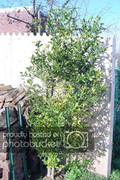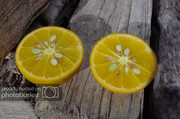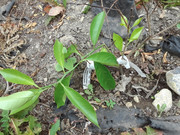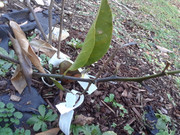There are a lot of people in colder climates who would like to grow a lime tree. Unfortunately for them, and something almost none of them realize, limes are the very
least hardy out of all the citrus groups commonly sold in a supermarket. If you wanted to try pushing the boundaries and see if a citrus tree might be able to survive in your marginal climate, a lime tree would be the very last thing you'd want to try.
But that being said, Kaffir lime is not actually a
true lime.
Regular limes descend from an ancestor called
Citrus micrantha, which has very little tolerance to cold. Kaffir limes, on the other hand, descend from a different ancestral species, Khasi papeda (
Citrus latipes ) which grows a bit further inland at a bit higher elevation.
This citrus species, C. latipes (Swingle) Yu. Tanaka is locally called as Soh Kymphor by the Khasi tribe of Meghalaya. This fruit is bitter sour in taste and commonly consumed raw. But, in a few local Khasi villages of Laitjem and Sadew, this fruit is eaten between meals, usually blended with finely cut tender leaves of mustard or radish with chillies, sugar and salt to taste.
Here are a few traditional uses of this plant:
The leaves of this citrus plant are boiled in water until the water turns green. Then this water is used for bathing, to relieve body aches, fever, common cold and headache.
The citrus fruit is peeled and boiled in water, then it is cooled and strained using muslin cloth and stored. This decoction is used by diluting it with water and consumed orally to cure stomach disorders, constipation and skin problems. It is also applied to heal chapped and dry skin.
The juice of the fruit is mixed with mustard oil and used as balm on the forehead and the nose during a fever or cold, to lower the body temperature. It also acts as an antiseptic when applied to cuts and wounds.
https://explorers.zizira.com/wild-citrus-fruits-meghalaya-uses/If you look at the leaves of Kaffir lime, they have huge winged petioles that are very reminiscent of Citrus Ichangensis (a notoriously cold hardy species). I don't know but this suggests there might be a distant relation. (Now of course this doesn't prove cold hardiness. Citrus micrantha itself also has fairly large winged petioles and is the last thing from cold hardy.)
(Note: I don't believe the C. latipes in the UCR collection is fully representative of the species in the wild, in terms of leaf shape)
This is a botanical drawing of Kaffir lime, note the leaf shape:
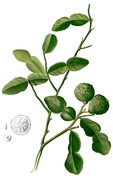
[another little thing I'll point out about the difference between C. micrantha and C. latipes is that C. micrantha has off the charts levels of furanocoumarins, which no doubt explains why lime juice is so photosensitizing; whereas Kaffir lime has only extremely low levels by comparison, based on this one fact alone one could infer different ancestry]
I've seen various different sources, some listing Kaffir lime as zone 10 (like most ordinary citrus) and some indicating it can survive down to zone 9.
The very fact it could be grown in zone 9 would indicate it is much hardier than ordinary limes.
Kaffir lime is rather a less common variety, so I'd imagine there hasn't been a lot of experimentation investigating whether it can survive in marginal climates. Probably most everyone just assumes it is going to be like any other ordinary citrus.
I suspect however that Kaffir lime might have a similar level of cold hardiness to Meyer lemon.
(And if that's the case there is a possibility it might be able to survive outside in urban areas of Vancouver, B.C., but I'm getting ahead of myself)
This entire thread is very speculative.
A comment left in a discussion about Kaffir lime:
________________________________________________
December 21, 2010,
jbwaters from Dallas, TX wrote:
I love this plant. I have had one in a pot for about 12 years now and it is still thriving. Mine fruits and I have been extremely successful with starting new ones from seeds -- i plant them directly from the fruit into moist soil -- about 95% sprouted and are either in the ground or given as gifts. In the summer, I have mine in dappled to direct sun until late afternoon and have positioned it so that I can see the Giant Swallowtails laying their eggs on it from my kitchen window-- their ceterpillars look like bird droppings. My tree is easily big enough to share with them. It doesn't seems to like our Texas sun as much as my Satsuma Orange does.
And despite the fact that the kaffir lime shouldn't survive freezing temps, I planted one in a slightly protected area near my house and despite records snows in Dallas, TX last year (12 inches over night that lasted with well below freezing temps for several days), the kaffir lime tree came back! They got about 2 feet tall with very little water or attention. So this year I planted more in the ground to see how they would do. My fruiting tree stays in the pot though as she is a rare thing to find and stays in the greenhouse once we hit 40 degrees until we are reliably in the 50s.
________________________________________________
https://davesgarden.com/guides/pf/go/67460/#bThe leaves of Kaffir lime are very useful for cooking with in Southeast Asian cuisine, used much the same way that bay leaves are.
(Unlike the leaves of other citrus, kaffir lime leaves are very mild and don't have the characteristic harsh astringency of other citrus leaves, which is probably reflective of its papeda ancestry)
The fruits, on the other hand, are much lower quality than normal limes, though not terrible (they just have somewhat less of the characteristic lime flavor, and a very slight amount of bitterness), but the fruits are sometimes valued for the zest that comes from the rinds. The zest is better than that which would come from regular limes.




